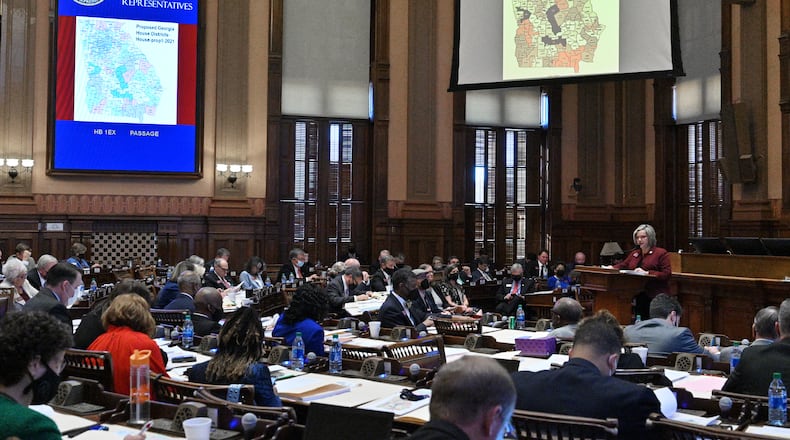No one knows yet what Georgia’s redrawn political map will look like come December, but the redistricting court case provides some clues.
A federal judge last week ordered state legislators to create a fifth majority-Black congressional district, located in west metro Atlanta, to ensure adequate representation that reflects population growth during the past decade. Currently, there are four predominantly Black districts in Georgia.
It will be up to the General Assembly to decide exactly how to shape new congressional districts that comply with the court’s ruling, which found that the 2021 redistricting by the Republican-run Legislature illegally weakened Black voters’ political power. U.S. District Judge Steve Jones also required seven additional majority-Black state House and state Senate districts.
Millions of Georgia voters could find themselves assigned to different districts before next year’s elections. Each of Georgia’s 14 districts must have the same number of residents, about 765,000.
An example map created by an expert witness for the plaintiffs shows one way the state could be redistricted when a special legislative session begins Nov. 29. State lawmakers haven’t released their proposed maps.
6th District
Credit: Isaac Sabetai
Credit: Isaac Sabetai
The centerpiece of the redistricting lawsuit was the 6th Congressional District, located in Atlanta’s northwest suburbs, where Republicans gained a seat in Congress that was previously held by Democratic U.S. Rep. Lucy McBath.
During the last round of map-drawing in 2021, the Republican-held General Assembly shifted the district’s borders into more rural and white areas where voters were more likely to support GOP candidates.
A proposed map by William Cooper, a redistricting expert for the plaintiffs, envisions a new 6th District that covers a majority-Black area west of Atlanta, including parts of Cobb and Fulton counties as well as all of Douglas County.
The current 6th District, represented by Republican U.S. Rep. Rich McCormick, includes more white and conservative communities in east Cherokee, northeast Cobb, Dawson, Forsyth, north Fulton and northwest Gwinnett counties.
Cooper’s proposed district encompasses an area where the Black population has increased by more than 938,000 since 2000, accounting for 75% of the statewide increase in Black residents this century, according to his court testimony.
GOP choices
Republican legislators in the General Assembly might try to find a way to preserve their 9-5 advantage among Georgia’s congressional delegation while also following the judge’s requirements, said Charles Bullock, a political science professor at the University of Georgia.
“Doing that and complying with the judge’s order, I think it’s going to be difficult,” said Bullock, author of the book “Redistricting: The Most Political Activity in America.” “I’m sure there are people already working on it.”
Possibilities could include shifting the 6th District’s boundaries with the 7th District in Gwinnett County, where McBath won election last year, and the 14th District, the overwhelmingly conservative northwest Georgia region held by Republican Rep. Marjorie Taylor Greene that includes a pocket of Cobb County.
Other experts see an easier path for Republicans to create maps that keep their advantage in Congress secure.
For example, the 7th District, which is already held by Democrats, might be drawn to include a Black majority, satisfying the judge’s order while maintaining Republicans’ advantage.
Credit: Contributed
Credit: Contributed
“Even if Rs are forced to draw a new Black majority seat in the western Atlanta burbs ... they could still easily gerrymander the rest of the lines to preserve their current 9R-5D edge,” Dave Wasserman, an editor and elections analysist for The Cook Political Report, wrote on X last week.
However, Jones’ ruling might prevent that possibility.
Jones wrote in his ruling that the state can’t remedy maps that violate the Voting Rights Act’s protections against racial discrimination by eliminating districts with substantial minority populations. The 7th District is roughly 31% Black, 30% white, 24% Hispanic and 16% Asian.
An uncertain path
The General Assembly, with its 57% Republican majority, probably won’t try to defy the judge’s order after that kind of strategy backfired in Alabama, Bullock said.
A court quickly rejected the Alabama Legislature’s attempt this summer to redistrict the state without adding a second majority-Black district, a decision that the U.S. Supreme Court let stand.
If the Georgia General Assembly passed a map that didn’t fulfill the judge’s requirements, the courts could take control of the redistricting process.
“There’s a strong incentive among legislators to want to keep control of the process,” Bullock said. “If they come up with an unacceptable map ... that could cause them even greater grief.”
In the meantime, before the special redistricting session begins at the state Capitol in a month, appeals of Jones’ order are likely. If appeals courts put Jones’ decision on hold, Georgia’s existing districts could remain in place during next year’s elections.
About the Author
Keep Reading
The Latest
Featured






